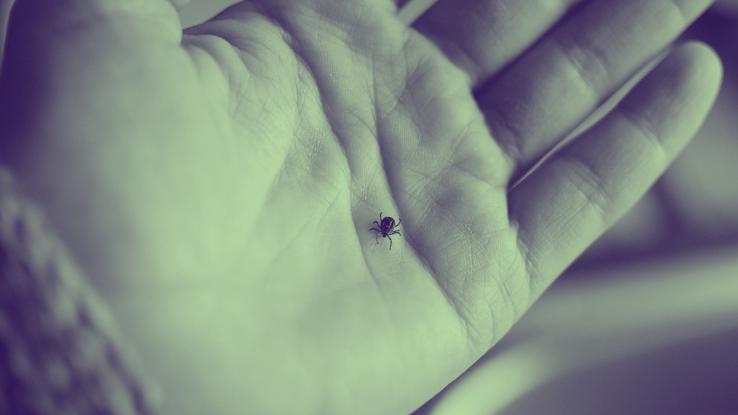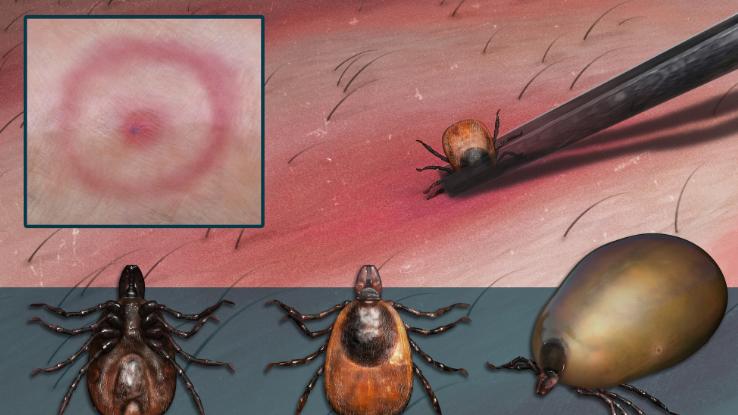How Do You Know if You Got All the Tick Out

Taking its name from the coastal town of Lyme, Connecticut, Lyme disease is the most common tick-borne disease in the United States. Then, what exactly causes Lyme disease? In short, the bacterium Borrelia burgdorferi, which is transmitted through tick bites, causes Lyme affliction.
While the bacterium can be transmitted by several species of tick, the biggest culprit is the black-legged deer tick. In society for an infection of Lyme disease to occur, the tick must remain attached to an private for at least 36 to 48 hours. However, other tick-borne infections can occur in a shorter amount of time. In fact, individuals who come down with Lyme disease can also be infected with other tick-borne diseases and atmospheric condition, such as Ehrlichiosis and Babesiosis, from the same seize with teeth.
The vast majority of cases occur during the warm leap and summer months, with 94% of all cases occurring in the following 12 states:
- Connecticut
- Delaware
- Maine
- Maryland
- Massachusetts
- Minnesota
- New Jersey
- New Hampshire
- New York
- Pennsylvania
- Virginia
- Wisconsin
It should also be noted that cases occur frequently in the northern, forested region of California.
The Three Stages of Lyme Disease
Stage I
- This stage occurs within a few weeks of the tick bite. At this stage, the effects of the infection are localized to the area surrounding the seize with teeth and include reddening and the development of the infamous bull's eye-shaped rash. The private may also feel general flu-similar symptoms.
Stage 2
- The intermediate stage occurs within the start months after infection. At this phase, the infection has spread and might cause multiple skin lesions. It can besides cause problems with the cardiac and neurological systems — though this only occurs in a low percent of cases.
Stage Three
- This last stage occurs several months to a year afterwards the initial infection. At this stage, the infection is widespread and may cause pain as well as neurological problems, including dementia. Lyme illness can nonetheless be treated at this phase, but the person will likely have some lasting effects.

Symptoms Associated With Lyme Disease
Lyme disease symptoms vary based upon the phase of the infection. In the start, it tin can be easy to error the symptoms as something equally simple every bit the influenza.
In stage one, symptoms may come up and go, and include:
- Headache
- Lightheadedness or fainting
- Fever
- Chills
- Stiff cervix
- Muscle aches
- Itching all over the body
- Malaise, or a general feeling of existence unwell
One of the nearly well-known symptoms associated with Lyme illness is tell-tale rash, also called Erythema Migrans. Although well-known, this bull's centre-shaped rash occurs in only 80% of cases of Lyme disease. Ofttimes, it will spread outward from the seize with teeth and can vary in size.
In stage two, symptoms may include:
- Musculus pain or joint paint
- Swelling in joints
- Paralysis or weakness in the face
- Heart problems, such as palpitations
- Hurting in the legs, especially in the night
- Headaches
Finally, symptoms associated with phase three include:
- Speech communication problems
- Articulation and musculus pain
- Musculus weakness
- Aberrant musculus movements
- Numbness and tingling
- Causes & Gamble Factors Associated With Lyme Affliction
As mentioned above, Lyme disease is caused exclusively by the bite of an infected tick. Most ofttimes, the ticks live in wooded and brushy areas. If you walk through their habitat — or if your pet does — the ticks may latch onto you, often migrating toward the warmer areas of the bodies to feed.
Of class, not everyone who is bitten past a tick will become Lyme disease, but it'due south best to exist cautious if you discover a tick on your trunk, wearing apparel or pet. Exist sure to thoroughly check your body for ticks after:
- Participating in outdoor activities such as gardening, hunting, or hiking in areas where ticks are known to inhabit
- Letting firm pets explore areas where ticks reside
- Walking in areas with loftier grass, such as fields
Diagnosing Lyme Disease
Diagnosing Lyme affliction tin can be challenging, namely because patients don't always observe their tick bite. Since the symptoms can be like to the flu and other illnesses, missing a tick bite can lead to a misdiagnosis.
If you doubtable you've experienced a tick seize with teeth, be certain to monitor your symptoms and inform your md. Additionally, it's helpful to document where your tick bite was and if you noticed whatever swelling or redness. Based on your symptoms, your doctor volition carry a series of tests to diagnose your condition and prescribe the most constructive treatment.
- Concrete Examination: Depending on your symptoms, your doctor may examine you to determine whatsoever abnormalities from rashes to joint swelling and neurological abnormalities. Depending on your symptoms, yous will likely need additional follow-upwardly tests. These physical examinations are preliminary and cannot conclusively diagnose Lyme disease — with one exception. If you develop the Erythema Migrans — that bull's eye-shaped rash that spreads outward from the bite — your doctor tin can confirm your diagnosis without further tests.
- Blood Test: A claret test can aid diagnose Lyme disease in all iii stages.
Treatment & Prevention
When it comes to prevention, the best affair you can exercise is remain aware. If you hike or walk in an area inhabited past ticks you should:
- Wear protective clothing that has been treated with tick repellent
- Avert wooded or grassy areas that have a high amount of leaf debris
- Walk in the center of trials
- Deport a full-torso tick check at least one time a day. Look in areas such as armpits, navels, groin, between legs, in the hair, and in and around the ears
- Bank check your gear and pets for ticks Note: Pets should receive regular tick prevention regimens. Contact your vet for more information.
If caught early on, treating Lyme disease is also fairly elementary. The near common antibiotic used in treating a Lyme disease infection is doxycycline. However, some people can't take this antibiotic, so amoxicillin or cefuroxime tin can be used instead, and then long every bit the dosage is higher and the treatment is longer in duration.
Other treatment options will depend upon the severity of the infection. For example, cardiac problems may be treated separately from the infection itself.
Complications Associated With Lyme Disease
Over fourth dimension, if left untreated, symptoms can become severe and lead to problems with the center, neurological system, muscles, and joints.
Moreover, at that place is a phenomenon called postal service-Lyme disease syndrome, which is currently being investigated past researchers. Although little is known about mail-Lyme illness syndrome, individuals discover that symptoms can exist chronic and impact their day-to-day lives even if they were treated for Lyme illness when symptoms first occurred.
With this in mind, treating Lyme disease early is essential for a full recovery. If you observe a tick on your body, remove it immediately — and properly. Even if you don't come across a tick, but find an unusual bite or experience symptoms of Lyme disease after venturing into a grassy or wooded area, seek medical attending immediately to ensure you receive proper handling.
Resources Links:
- "Lyme borreliosis: diagnosis and management" via BMJ
- "Lyme borreliosis" via Nature
- "Review of European and American guidelines for the diagnosis of Lyme borreliosis" via ScienceDirect
- "Lyme disease: A rigorous review of diagnostic criteria and handling" via ScienceDirect
- "Diagnosis, Treatment, and Prevention of Lyme Affliction, Human Granulocytic Anaplasmosis, and Babesiosis" via JAMA Network
- "Lyme Disease — Connecticut" via Centers for Affliction Command and Prevention (CDC)
- "Tick Removal" via Centers for Illness Control and Prevention (CDC)
Source: https://www.symptomfind.com/health/condition-lyme-disease?utm_content=params%3Ao%3D740013%26ad%3DdirN%26qo%3DserpIndex
0 Response to "How Do You Know if You Got All the Tick Out"
Post a Comment